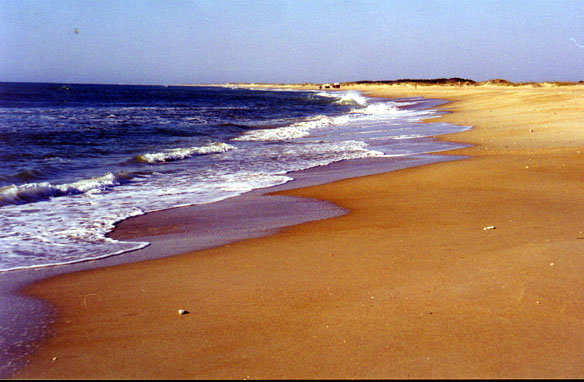
.
Cape Lookout National Seashore has three distinct ecological zones. These zones are like all of the islands of the North Carolina Outer Banks. These zones are the ocean, the shoreline, and dunes. Each zone is home to different kinds of plants and animals.

Waves crash against the shoreline, and the offshore sand and sea grass beds are home to a variety of fishes and invertebrates. Small fishes and invertebrates find shelter in the sea grass beds, and some fishes find camouflage in the sand. Stingrays are a type of fish that are often found in the sand in shallow water near the shore. Southern stingrays, roughtail stingrays, and Atlantic stingrays can be found at Cape Lookout National Seashore.
This photograph of waves on the shoreline shows a pattern. One set of waves has already crashed, and its water is running back down the beach into the sea. Another wave is crashing behind it, and will surge up onto the beach in moments. As the water runs back down the beach, some of it seeps into the sand. Remember that sea water is rich with plankton. Some of the plankton is deposited in the sand by the action of the waves, leaving food behind for crabs and insects. These crabs and insects are food for shorebirds and migratory birds. The action of the waves is an engine for the life on the Outer Banks.

Notice the smooth beach between the ocean and the dunes. This smooth beach is the intertidal zone. The intertidal zone is where you might find a conch shell washed up on the shore. Cape Lookout National Seashore is covered with seashells. The dunes start above the high water mark from the high tide. Sand is moved back and forth by the wind and the waves. The dunes are high enough to escape the action of waves. Here, grasses can take root. These grasses keep the sand from being blown away by the wind. Grasslands are important for preserving the islands, keeping the sand from being blown into the sea. These grasslands also are an important food resource for insects and birds.